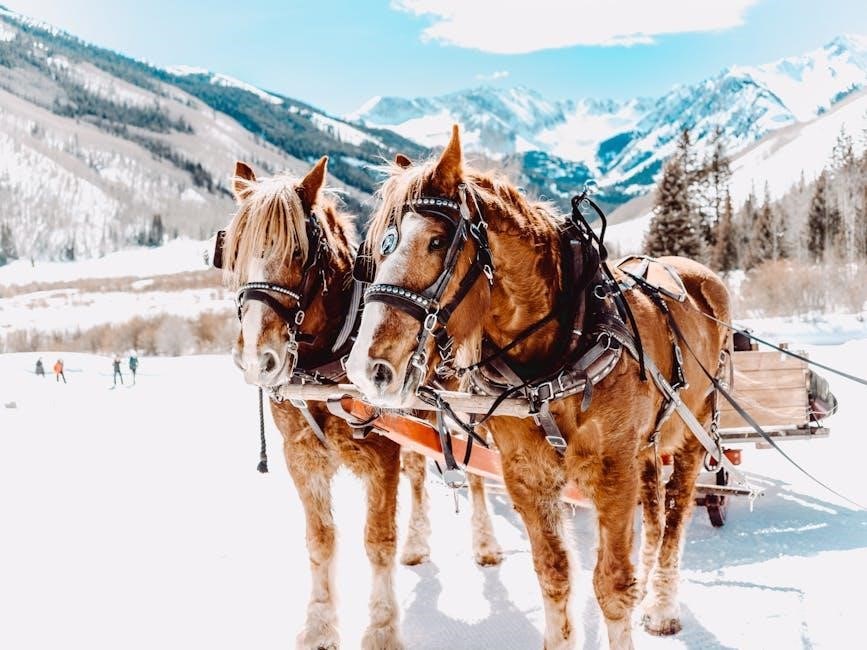The Western Snow Plow is a critical tool for winter maintenance, ensuring safe road conditions. However, like any equipment, it can face mechanical issues. This guide provides troubleshooting solutions and maintenance tips to help operators identify and resolve common problems, ensuring optimal performance during snowy conditions.
1.1 Importance of Regular Maintenance
Regular maintenance is crucial for ensuring the reliability and efficiency of your Western Snow Plow. Proper inspections and timely repairs prevent unexpected breakdowns, optimize performance, and extend equipment lifespan. Addressing wear and tear early reduces downtime and operational costs, ensuring your plow operates safely and effectively during harsh winter conditions.
1.2 Objective of the Guide
This guide aims to empower Western Snow Plow operators with practical knowledge to diagnose and resolve common issues. By providing step-by-step solutions and expert tips, it ensures efficient troubleshooting, minimizing downtime. The objective is to enhance operational reliability, safety, and performance, helping users maintain their equipment effectively throughout the winter season.
Common Issues with Western Snow Plows
Common issues include blade malfunctions, hydraulic system failures, and electrical connectivity problems. These problems can hinder plowing efficiency and safety, requiring prompt diagnosis and resolution.
2.1 Blade Not Raising Properly
If the blade fails to raise, check for hydraulic leaks, damaged cylinders, or faulty electrical switches. Ensure the hydraulic fluid level is adequate and connections are secure. Inspect for obstructions or mechanical damage. Addressing these issues promptly prevents further complications and ensures safe, efficient plowing operations during winter conditions.
2;2 Poor Plowing Performance
Poor plowing performance can result from improper blade angle, insufficient downforce, or excessive plowing speed. Check blade alignment, adjust the tilt settings, and ensure the plow is moving at a consistent, appropriate speed. Addressing these factors enhances efficiency and ensures effective snow removal, maintaining road safety and equipment performance during winter operations.
2.3 Hydraulic System Malfunctions
Hydraulic system malfunctions can cause blade movement issues, affecting plowing efficiency. Common problems include low fluid levels, cylinder damage, or faulty valves. Inspect for fluid leaks, check for blockages, and ensure proper system pressure. Addressing these issues promptly prevents further damage and ensures reliable operation during critical winter conditions.

Pre-Trip Inspection Checklist
A pre-trip inspection ensures the snow plow is ready for operation. Check hydraulic fluid levels, blade condition, electrical connections, and safety features to prevent issues during use.
3.1 Hydraulic Fluid Level Check
Regularly inspect the hydraulic fluid level to ensure optimal system performance. Low levels can cause malfunctions, so top up as needed using the recommended fluid type. Always refer to the manufacturer’s guidelines for correct procedures to avoid contamination and maintain system efficiency throughout the plowing season.
3.2 Blade Condition and Alignment
Inspect the blade for wear, dents, or damage. Ensure proper alignment with the plow frame to maintain even ground contact. Misalignment can reduce plowing efficiency and cause uneven wear. Adjust the blade as needed and replace worn components to ensure consistent performance and extend the lifespan of your Western Snow Plow.
3.3 Electrical Connections and Switches
Check all electrical connections for tightness and corrosion. Inspect switches for proper function and clean or replace them if necessary. Ensure the wiring harness is secure and free from damage. Faulty electrical components can disrupt plow operations, so addressing these issues promptly is crucial for reliable performance during snow removal tasks.

Hydraulic System Troubleshooting
Identify and resolve hydraulic system issues, such as fluid leaks or cylinder malfunctions, to ensure proper plow operation. Regular checks and timely repairs are essential.
4.1 Low Hydraulic Fluid Level
A low hydraulic fluid level can cause malfunctioning of the plow’s components. Always check the fluid reservoir during pre-trip inspections. If the level is below the minimum mark, refill with the recommended hydraulic fluid to maintain system pressure and ensure smooth operation of the snow plow.
4.2 Cylinder Malfunction
4.3 Hydraulic Valve Issues
Hydraulic valve issues can disrupt fluid flow, causing inconsistent plow movement. Symptoms include erratic blade operation or complete system failure. Inspect valves for blockages or wear. Test valve operation by cycling the plow. Replace faulty valves promptly to restore proper hydraulic function and ensure reliable snow plow performance during winter operations.
Hydraulic valve issues can cause inconsistent fluid flow, leading to erratic blade movement or system failure. Inspect for blockages, wear, or electrical faults. Test valve operation by cycling the plow. Clean or replace faulty valves to restore proper hydraulic function, ensuring smooth and reliable snow plow performance during winter operations.

Electrical System Issues
Electrical system issues can disrupt snow plow operations, often due to faulty switches, wiring problems, or sensor malfunctions. Regular checks and prompt repairs are essential to maintain reliability and ensure safe, efficient snow removal.
5.1 Faulty Switches
Faulty switches can cause intermittent or complete loss of electrical control over the snow plow. Common issues include worn-out buttons, corroded terminals, or loose connections. Always check for erratic switch behavior or failure to activate plow functions. Clean corrosion, tighten connections, and replace damaged switches to restore proper operation. Consult the service manual for specific guidance.
5.2 Wiring Problems
Wiring issues can disrupt electrical signals, causing malfunctions. Check for damaged, corroded, or loose connections, especially in harsh weather conditions. Inspect wires for abrasions or rodent damage. Use a multimeter to test circuits and identify shorts or open connections. Clean corroded connectors and replace damaged wires to ensure proper signal flow and operation.
5.3 Sensor Malfunctions
Sensor malfunctions can disrupt plow operations by providing inaccurate readings. Check for dirt, ice, or moisture interfering with sensors. Clean or replace faulty sensors to restore accurate data transmission. Calibrate sensors if necessary to ensure proper function and reliable performance during plowing operations. Addressing sensor issues promptly prevents operational delays and safety hazards.

Blade and Cutting Edge Maintenance
Inspect the blade for wear and damage, replacing the cutting edge when necessary. Ensure proper alignment and tighten loose bolts to maintain optimal plowing performance and longevity.
6.1 Blade Alignment Adjustment

Proper blade alignment is essential for effective snow plowing. Misalignment can cause uneven wear and decreased performance. To adjust, refer to the operator’s manual, loosen adjustment bolts, align the blade to the vehicle using a level, and tighten securely. Regular checks ensure optimal plowing efficiency and extend equipment lifespan.
6.2 Cutting Edge Wear and Replacement
The cutting edge is crucial for effective plowing, as it directly contacts the surface. Inspect regularly for wear or damage; a worn edge reduces performance. Replace when edges show significant wear or unevenness. Proper replacement ensures consistent plowing results and prevents damage to the blade or vehicle. Always use genuine Western parts for optimal durability.
6.3 Blade Angle Adjustment
Proper blade angle adjustment is essential for effective snow plowing. The angle affects how snow is cleared and can impact the plow’s performance and longevity. To adjust, start by inspecting the blade for alignment and wear. Use a gauge or tool to measure the angle, typically between 30° to 45°, depending on the surface type. Adjust by loosening the bolts and repositioning the blade, then tighten securely. Check the angle regularly and adjust as needed to ensure optimal performance and safety. Refer to the user manual for specific instructions and tools required. Regular adjustments prevent uneven wear and enhance plowing efficiency, ensuring the blade operates smoothly in various conditions. This process is crucial for maintaining the plow’s effectiveness and extending its lifespan.

Lift and Tilt Function Problems
Lift and tilt issues can hinder plowing efficiency. Common problems include slow or incomplete lifting, uneven tilting, or total malfunction. Check for obstructions, fluid levels, and cylinder damage. Regular maintenance and inspections help prevent these issues, ensuring smooth operation and safety while plowing.
7.1 Plow Not Lifting
If the plow fails to lift, check the hydraulic fluid level and look for leaks. Inspect for blockages in the lift system and ensure all electrical connections are secure. Faulty switches or wiring issues may also cause this problem. Addressing these issues promptly ensures safe and efficient plowing operations.
7.2 Tilt Function Malfunction
A malfunctioning tilt function may result from hydraulic system issues or electrical problems. Check for low hydraulic fluid levels, damaged hoses, or faulty valves. Inspect electrical connections for wear or corrosion; Ensure the tilt switch is functioning correctly. Addressing these issues promptly prevents further damage and ensures proper plow alignment for effective snow removal.
7.4 Solving Lift and Tilt Issues
Addressing lift and tilt issues involves checking the hydraulic system for fluid levels and leaks, inspecting cylinders for damage, and ensuring electrical connections are secure. Verify sensors are functioning and adjust blade alignment as needed. Lubricate moving parts regularly and consider preventive maintenance to avoid future problems. Always follow safety guidelines during repairs.
8.1 Inadequate Downforce
Inadequate downforce can reduce plowing efficiency. Check for worn or damaged springs and adjust or replace them as needed. Ensure proper hydraulic pressure and inspect the blade angle. Adjusting the tilt and angle settings can improve downforce. Regular lubrication of moving parts and timely maintenance also help maintain optimal plowing performance.
8.2 Plowing Speed Adjustments
Adjusting plowing speed is crucial for efficient snow removal. Reduce speed for heavy snow or ice to maintain blade contact and avoid skipping. Increase speed for lighter snow conditions to cover more area. Proper blade angle and downforce also impact performance. Optimize speed based on snow density and blade settings for better results.
8.3 Blade Angle and Tilt Settings
Proper blade angle and tilt settings are essential for effective snow removal. Adjusting the blade angle ensures snow is thrown consistently, while tilt settings prevent uneven wear. Optimal settings vary by conditions; steeper angles for heavy snow, flatter for light. Regular adjustments maintain performance and extend equipment lifespan.

Winterizing Your Snow Plow
Winterizing your snow plow is essential for maintaining its performance and longevity. It involves cleaning, lubricating moving parts, and storing it properly to prevent corrosion and wear.
9.1 Cleaning the Plow
Cleaning the plow is crucial for maintaining efficiency and preventing corrosion. Remove dirt, ice, and debris from the blade and frame. Use a pressure washer for thorough cleaning, then inspect for damage or wear. Apply a rust-inhibiting coating to protect metal surfaces during storage.
9.2 Lubricating Moving Parts
Lubricating moving parts is essential to prevent corrosion and wear. Apply high-quality, water-resistant grease to hinges, hydraulic cylinders, and springs. Regular lubrication ensures smooth operation and extends equipment life. Refer to your owner’s manual for recommended grease types. Wipe off excess to avoid attracting dirt and debris.
9.3 Storage Tips

Store your Western Snow Plow in a clean, dry, well-ventilated area. Protect it from direct sunlight and moisture to prevent rust. Use a breathable cover to shield from dust. Secure the plow to prevent movement during storage. Inspect for damage and address any issues before storing. Consult your owner’s manual for specific recommendations.
Safety Tips and Best Practices
Always wear protective gear, ensure proper visibility, and stay alert while operating. Follow manufacturer guidelines and conduct regular safety checks to prevent accidents and injuries during plowing operations.
10.1 Pre-Operation Safety Checks
Before starting, inspect the plow for damage or wear. Check hydraulic fluid levels, electrical connections, and blade alignment. Ensure all safety lights and signals are functioning. Wear appropriate protective gear, including gloves and goggles. Review the operation area for obstacles and ensure bystanders are at a safe distance to avoid accidents.
10.2 Safe Operating Practices
Operate the plow at moderate speeds to maintain control. Avoid sudden movements to prevent loss of balance. Keep a safe distance from vehicles and pedestrians. Use plow lights and signals for visibility. Plow in the direction of oncoming traffic when possible. Monitor weather conditions and adjust speed accordingly to ensure safe and effective snow removal.
10.3 Post-Operation Routine
After operation, turn off the engine and let it cool. Inspect the plow for damage or wear. Clean the blade and remove snow residue. Lubricate moving parts to prevent rust. Check hydraulic and electrical systems for leaks or damage. Store the plow in a dry, secure location. Drain fuel if storing long-term.
When to Call a Professional
If encountering complex issues beyond DIY fixes, such as severe hydraulic system failures or significant blade damage, it’s crucial to consult a certified professional to ensure proper repairs.
11.1 Major Hydraulic Repairs
Major hydraulic repairs, such as replacing damaged cylinders or rebuilding pumps, require specialized tools and expertise. If you encounter severe hydraulic system failures or critical component damage, consult a certified professional to ensure proper repairs and maintain safety and performance.
11.2 Complex Electrical Issues
Complex electrical issues, such as wiring malfunctions or control system failures, often require professional expertise. If you encounter symptoms like intermittent power loss or unresponsive controls, consult a certified technician to diagnose and repair the problem, ensuring your snow plow operates safely and efficiently.
11.3 Blade or Frame Damage
Blade or frame damage can severely impair your snow plow’s functionality. Inspect for bends, cracks, or rust. Avoid DIY repairs, as improper fixes can worsen damage. Consult a professional for accurate assessment and rebuilding, ensuring structural integrity and safe operation.
This guide provides essential troubleshooting strategies for Western Snow Plows, ensuring safety and efficiency. Regular maintenance and timely repairs are crucial for optimal performance during harsh winter conditions.
12.1 Summary of Key Points
This guide covers essential troubleshooting strategies for Western Snow Plows, emphasizing regular maintenance, hydraulic and electrical system care, blade alignment, and safety practices. Addressing issues like poor plowing performance and hydraulic malfunctions ensures reliability. Proper pre-trip inspections and timely repairs prevent downtime, while professional intervention is recommended for complex problems, ensuring optimal winter performance.
12.2 Encouragement for Regular Maintenance
Regular maintenance is crucial for ensuring your Western Snow Plow performs reliably during harsh winter conditions. By addressing issues early, you can prevent costly repairs and downtime. Consistent checks and timely repairs enhance safety, efficiency, and longevity. Make maintenance a priority to keep your plow running smoothly and effectively throughout the season.

